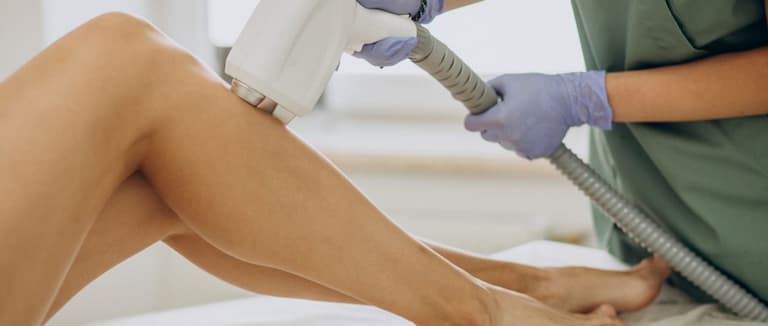Laser Hair Removal: Benefits, Risks, and Long-Term Results
Unwanted body hair is a common source of discomfort, especially for women. While traditional hair removal methods rarely offer lasting results, advances in technology have made laser hair removal a leading option for achieving smoother skin over time. This procedure can gradually reduce or even eliminate body hair, but it's important to be aware that it also carries certain risks.

Laser Hair Removal
Laser hair removal is a widely used cosmetic procedure for reducing unwanted hair. It works by directing laser light at the pigment, called melanin, within hair follicles. This light energy is absorbed and transformed into heat, which damages the follicles and inhibits future hair growth. With multiple sessions, laser hair removal can offer long-lasting reduction in hair and, in some cases, permanent results.
How Laser Hair Removal Works:
- Procedure: During a laser hair removal session, a trained technician or medical professional uses a handheld laser device to target the areas where you want to remove unwanted hair. The laser emits short pulses of light directed at the hair follicles. The pigment in the hair follicles absorbs the light and damages the follicles.
- Safety: Laser hair removal is generally considered safe when performed by a qualified and experienced professional. However, there can be side effects such as redness, swelling, and temporary skin irritation. It's important to choose a reputable clinic and follow pre- and post-care instructions.
- Effectiveness: The effectiveness of laser hair removal can vary depending on factors such as hair color, skin color, and the type of laser used. Laser hair removal is typically more effective in individuals with light skin and dark hair due to the contrast between skin and hair color, which makes it easier for the laser to target the hair follicles.
- Multiple Sessions: Laser hair removal is not a one-time procedure. Typically, a series of sessions (usually 6 to 8) are required to achieve the best results. Multiple sessions spaced several weeks apart are necessary to effectively target all hair follicles.
- Treatment Areas: Laser hair removal can be performed on various body areas including the face, arms, legs, underarms, bikini line, and more.
- Long-Term Hair Reduction: While laser hair removal can result in significant hair reduction, it may not always lead to complete permanent hair removal. Some individuals may experience regrowth over time, but the regrown hair is often finer and lighter in color.
Before starting laser hair removal, consult a qualified practitioner who can assess your skin and hair type to see if the procedure is right for you. Following your provider's recommended treatment plan is key to achieving the best and safest results.
Types of Laser Hair Removal Devices:
Laser hair removal devices come in various types that utilize different technologies and wavelengths of light. The selection of the device depends on factors such as the patient's skin type, hair color, and specific treatment needs. Here are some types of common laser hair removal devices:
- Alexandrite Lasers: These lasers use an alexandrite crystal to produce a specific light wavelength (755 nm). They are known for their effectiveness on fair and olive-toned individuals and are one of the systems suitable for larger treatment areas at an appropriate speed.
- Diode Lasers: Diode lasers (typically 810 nm or 808 nm) are versatile and work well for different skin and hair types. They are known for their ability to penetrate deep into the skin, making them effective for dark or thick hair on light or medium-toned individuals.
- Nd:YAG Lasers: Neodymium-doped yttrium aluminum garnet (Nd:YAG) lasers emit light at a longer wavelength (1064 nm) and are effective for all skin types, including darker skin. They are often used in cases where other lasers may not be safe due to higher levels of melanin.
- Ruby Lasers: Ruby lasers (694 nm) are less commonly used today but are effective for light-toned skin and fine hair. They may be less comfortable due to a smaller spot size and higher level of discomfort.
- IPL (Intense Pulsed Light): IPL devices are not true lasers but use a broad range of light to target hair follicles. They are less specific in targeting compared to traditional lasers. IPL devices are particularly less effective for individuals with darker skin or lighter hair.
- Long-Pulsed Lasers: Long-pulsed lasers, including devices like GentleYAG and GentleLASE, use longer pulse durations and are suitable for all skin types, effectively reducing hair growth.
- Fractional Lasers: Fractional lasers, such as Fraxel or Pixel lasers, are primarily used for reshaping the skin surface and solving skin problems. Although not specifically designed for hair removal, some newer fractional devices have been developed to target hair.
- Pulsed Diode Arrays: These lasers use a high-intensity diode laser bar to provide multiple wavelengths and pulse durations, adaptable for different hair and skin types.
When considering laser hair removal, always consult with a qualified practitioner who can assess your skin and hair type. They will recommend the best laser technology for your unique needs. Choosing the right device is crucial for both the safety and effectiveness of the procedure, so individual evaluation is essential.

What are the risks of Laser Hair Removal?
Laser hair removal is generally safe and effective when carried out by a qualified, experienced practitioner. However, as with any medical or cosmetic procedure, there are some potential risks and side effects to consider. These may include:
- Pain or Discomfort: During the procedure, some people may experience pain or discomfort similar to the sensation of a rubber band snapping. However, this pain is usually mild and tolerable for most people.
- Skin Irritation: Following the procedure, skin redness, swelling, and localized irritation may occur.
- Changes in Skin Pigmentation: Laser hair removal, particularly in individuals with dark skin tones, can cause temporary changes in skin pigmentation. This may manifest as either lightening (hypopigmentation) or darkening (hyperpigmentation) of the treated skin. These changes are usually temporary but may persist in some cases.
- Burns and Blisters: In rare cases, laser hair removal may cause blisters or burns. This is more likely to occur if the procedure is not performed correctly or if the practitioner uses a laser type unsuitable for your skin type.
- Scarring: Although rare, laser hair removal can lead to scarring, especially in individuals with a history of keloid or hypertrophic scarring.
- Eye Injuries: Since lasers emit intense light, they can cause damage to the eyes. Both the patient and the practitioner should wear protective goggles during the procedure.
- Regrowth of Hair: In some cases, after initially experiencing a reduction in hair growth, some hairs may regrow. This can occur due to various reasons, including hormonal changes.
- Infections: There is a risk of infection if the equipment or facility is not properly disinfected.
- Herpes Outbreaks: Individuals with a history of cold sores or herpes simplex virus may experience herpes outbreaks due to the heat generated by the laser.
- Skin Sensitivity: Laser-treated skin may become more sensitive to the sun and more prone to sunburn. It is important to take post-procedural sun protection measures, such as using sunscreen and avoiding sun exposure.
* Liv Hospital Editorial Board has contributed to the publication of this content .
* Contents of this page is for informational purposes only. Please consult your doctor for diagnosis and treatment. The content of this page does not include information on medicinal health care at Liv Hospital .
For more information about our academic and training initiatives, visit Liv Hospital Academy
Frequently Asked Questions
What is laser hair removal?
Laser hair removal is a cosmetic procedure that uses concentrated light beams to target and damage hair follicles, reducing or eliminating unwanted hair growth.
Is laser hair removal permanent?
It provides long-lasting results, but complete permanence isn’t guaranteed. Some hair may regrow over time, usually finer and lighter than before.
How many sessions are needed?
Most people need 6 to 8 sessions spaced several weeks apart to achieve optimal results. Maintenance sessions may be needed later.
Is laser hair removal painful?
Most patients describe the sensation as mild discomfort, similar to a rubber band snap against the skin. Numbing creams can minimize pain.
Which areas can be treated?
Laser hair removal can be done on the face, arms, legs, underarms, back, chest, and bikini area, among others.
Who is a good candidate for laser hair removal?
It works best for people with light skin and dark hair, though newer laser technologies are safe and effective for all skin types.
Are there any side effects?
Mild redness, swelling, or temporary skin irritation may occur. Rarely, changes in pigmentation or minor burns can happen if performed improperly.
Can laser hair removal be done on sensitive skin?
Yes, but it should be performed by an experienced professional who can adjust settings for sensitive or darker skin tones.
How should I prepare for the procedure?
Avoid sun exposure, tanning, and waxing for several weeks before treatment. Shave the treatment area the day before your appointment.
Why choose Liv Hospital for laser hair removal?
Liv Hospital offers advanced laser technologies and expert dermatologists to ensure safe, effective, and personalized hair removal treatments.



